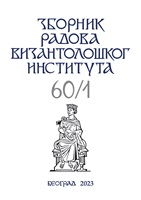НОВОПЛАТОНИЗАМ У ВИЗАНТИЈСКОЈ И РАНОЈ СРПСКОЈ ФИЛОСОФИЈИ: ДИЈАГРАМ КРУГА И ПОЛУПРЕЧНИКА
NEOPLATONISM IN BYZANTINE AND EARLY SERBIAN PHILOSOPHY: THE CIRCLE AND RADII DIAGRAM
Author(s): Vladimir Lj. CvetkovićSubject(s): Cultural history, Metaphysics, Social history, Philosophy of Middle Ages, Philosophy of Religion, Ontology
Published by: Vizantološki institut SANU
Keywords: circle and radii analogy; Neolatonism; Dionysius the Areopagite; Maximus the Confessor; procession; conversion; logoi;
Summary/Abstract: The paper examines some of the main metaphysical concepts of the thought of Dionysius the Areopagite and Maximus the Confessor, such as unity, differentiation, movement, limit, and logoi, in the context of the metaphor of circles and radii. It begins with an analysis of simple diagrams that appear in some Greek and Slavonic manuscripts of Dionysius’ works On the Divine Names. The paper goes on to examine more complex diagrams involving a circle or square centre, outer circumference, concentric rings, multicoloured radii and twisted cruciform bands that accompany the Instructions of Dorotheus of Gaza in many Greek and Slavic manuscripts. The paper argues that these new diagrammatic elements were employed to visualize complex ideas such as the Holy Trinity as unity of differentiations, the ontological limit of creation set by divine providence, the triadic structure of logoi of beings and the double movement of procession and reversion.
Journal: Зборник радова Византолошког института
- Issue Year: 2023
- Issue No: 60/1
- Page Range: 599-632
- Page Count: 34
- Language: Serbian

